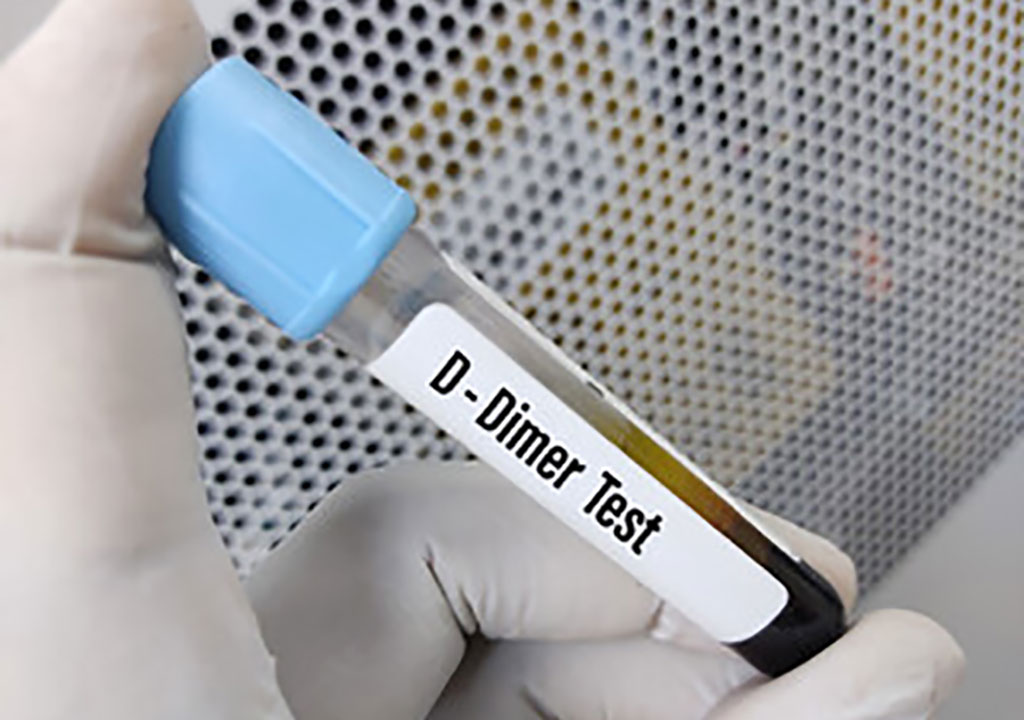D-Dimer Test Can Still Help Rule Out Pulmonary Embolisms in Hospitalized COVID-19 Patients
|
By HospiMedica International staff writers Posted on 27 Oct 2021 |

The D-dimer test can still be helpful in ruling out pulmonary embolisms in hospitalized COVID-19 patients, according to a new study.
Researchers at the University of South Florida Health Morsani College of Medicine (USF Health; Tampa, FL, USA) conducted a single-center, diagnostic study to investigate how well D-dimer testing performed at excluding pulmonary embolism in patients hospitalized with COVID-19. They found that the screening blood test originally validated in seriously ill patients without COVID-19 is still clinically useful for ruling out pulmonary embolism in patients hospitalized with the coronavirus.
Pulmonary embolisms occur when blood clots that form in another part of the body (often the leg), travel through the bloodstream, and lodge in the blood vessels of the lung, decreasing blood flow and causing low oxygen levels. Research indicates COVID-19 patients are three to 10 times more likely to develop pulmonary embolisms than other hospitalized patients, even when they are not as seriously ill or immobilized. Scientists are still investigating why, but it appears the COVID-19 virus may create a cellular environment that promotes clotting by making the inside of blood vessels uneven, irritated, and prone to microtears.
Doctors who suspect pulmonary embolisms routinely rely on widely available D-dimer screening to rule out the potentially life-threatening blood clotting disorder – most commonly in surgical patients immobilized for long periods and patients admitted to intensive care units. D-dimer is a simple blood test that measures protein fragments of blood clots floating in the bloodstream. D-dimer levels, normally undetectable or detectable at very low levels, rise sharply when the body is breaking down the clots. A negative D-dimer test (one that rules out pulmonary embolism) can help patients avoid more expensive, invasive diagnostic tests, like a computed tomography pulmonary angiogram, or CTPA.
The USF Health researchers wondered if the increased risk for blood clotting in COVID-19 patients, and uncertainty of diverse D-dimer values found in earlier smaller studies, reduced the existing screening tool’s ability to correctly rule out pulmonary embolism in COVID patients. The conventional thinking was that D-dimer levels would almost always be high in COVID-19 patients, therefore the test as originally validated (in non-COVID patients) would not be accurate at differentiating COVID patients without clots.
The restrospective study looked at the records of 1,541 patients hospitalized with COVID-19 at Tampa General Hospital from Jan. 1, 2020, to Feb. 5, 2021. They compared plasma D-dimer concentrations with CTPA, the criterion for diagnosing pulmonary embolism, in 287 of those patients. All COVID-19 patients with CTPA evidence of pulmonary embolism had D-dimer levels of 0.05 μg/mL or greater, as did the majority (91.2%) of patients without CTPA evidence of pulmonary embolism. (Concentrations of 0.05 μg/mL and higher are considered positive for pulmonary embolism, while anything below that D-dimer level is negative). The researchers also analyzed whether changing the cutoff levels defining positive or negative D-dimer test results specifically for the COVID patient population might improve the test’s performance.
Within the limitations of this single-center study, setting higher D-dimer thresholds was associated with improved specificity – but at “the cost of an increased false-negative rate that could be associated with an unacceptable patient safety risk,” the study authors wrote. A false-negative result means that the test does not detect a pulmonary embolism when the serious blood clotting problem is very likely present. While clinicians must maintain heightened suspicion for pulmonary embolisms when evaluating symptoms in COVID-19 patients, the overall USF Health study results indicate that the currently available D-dimer test adequately screens for the likelihood of pulmonary embolism in hospitalized COVID patients.
“Our study found that clinicians can feel confident interpreting the D-dimer levels the same in COVID patients as they do in every other patient; we don’t need a special (different) value for COVID patients,” said principal investigator Asa Oxner, MD, associate professor and vice chair of USF Health Internal Medicine. “So, in hospitalized COVID patients, we can appropriately rule out a pulmonary embolism if d-dimer levels are low.”
“The mechanisms of developing pulmonary embolisms may differ for COVID patients, but the resulting physiology is the same for all patients. The little fragments of (undissolved) blood clots are still detectable with D-dimer,” said Oxner.
Related Links:
USF Health
Latest COVID-19 News
- Low-Cost System Detects SARS-CoV-2 Virus in Hospital Air Using High-Tech Bubbles
- World's First Inhalable COVID-19 Vaccine Approved in China
- COVID-19 Vaccine Patch Fights SARS-CoV-2 Variants Better than Needles
- Blood Viscosity Testing Can Predict Risk of Death in Hospitalized COVID-19 Patients
- ‘Covid Computer’ Uses AI to Detect COVID-19 from Chest CT Scans
- MRI Lung-Imaging Technique Shows Cause of Long-COVID Symptoms
- Chest CT Scans of COVID-19 Patients Could Help Distinguish Between SARS-CoV-2 Variants
- Specialized MRI Detects Lung Abnormalities in Non-Hospitalized Long COVID Patients
- AI Algorithm Identifies Hospitalized Patients at Highest Risk of Dying From COVID-19
- Sweat Sensor Detects Key Biomarkers That Provide Early Warning of COVID-19 and Flu
- Study Assesses Impact of COVID-19 on Ventilation/Perfusion Scintigraphy
- CT Imaging Study Finds Vaccination Reduces Risk of COVID-19 Associated Pulmonary Embolism
- Third Day in Hospital a ‘Tipping Point’ in Severity of COVID-19 Pneumonia
- Longer Interval Between COVID-19 Vaccines Generates Up to Nine Times as Many Antibodies
- AI Model for Monitoring COVID-19 Predicts Mortality Within First 30 Days of Admission
- AI Predicts COVID Prognosis at Near-Expert Level Based Off CT Scans
Channels
Critical Care
view channel
CPR Guidelines Updated for Pediatric and Neonatal Emergency Care and Resuscitation
Cardiac arrest in infants and children remains a leading cause of pediatric emergencies, with more than 7,000 out-of-hospital and 20,000 in-hospital cardiac arrests occurring annually in the United States.... Read more
Ingestible Capsule Monitors Intestinal Inflammation
Acute mesenteric ischemia—a life-threatening condition caused by blocked blood flow to the intestines—remains difficult to diagnose early because its symptoms often mimic common digestive problems.... Read more
Wireless Implantable Sensor Enables Continuous Endoleak Monitoring
Endovascular aneurysm repair (EVAR) is a life-saving, minimally invasive treatment for abdominal aortic aneurysms—balloon-like bulges in the aorta that can rupture with fatal consequences.... Read more
Wearable Patch for Early Skin Cancer Detection to Reduce Unnecessary Biopsies
Skin cancer remains one of the most dangerous and common cancers worldwide, with early detection crucial for improving survival rates. Traditional diagnostic methods—visual inspections, imaging, and biopsies—can... Read moreSurgical Techniques
view channel
Robotic Assistant Delivers Ultra-Precision Injections with Rapid Setup Times
Age-related macular degeneration (AMD) is a leading cause of blindness worldwide, affecting nearly 200 million people, a figure expected to rise to 280 million by 2040. Current treatment involves doctors... Read more
Minimally Invasive Endoscopic Surgery Improves Severe Stroke Outcomes
Intracerebral hemorrhage, a type of stroke caused by bleeding deep within the brain, remains one of the most challenging neurological emergencies to treat. Accounting for about 15% of all strokes, it carries... Read morePatient Care
view channel
Revolutionary Automatic IV-Line Flushing Device to Enhance Infusion Care
More than 80% of in-hospital patients receive intravenous (IV) therapy. Every dose of IV medicine delivered in a small volume (<250 mL) infusion bag should be followed by subsequent flushing to ensure... Read more
VR Training Tool Combats Contamination of Portable Medical Equipment
Healthcare-associated infections (HAIs) impact one in every 31 patients, cause nearly 100,000 deaths each year, and cost USD 28.4 billion in direct medical expenses. Notably, up to 75% of these infections... Read more
Portable Biosensor Platform to Reduce Hospital-Acquired Infections
Approximately 4 million patients in the European Union acquire healthcare-associated infections (HAIs) or nosocomial infections each year, with around 37,000 deaths directly resulting from these infections,... Read moreFirst-Of-Its-Kind Portable Germicidal Light Technology Disinfects High-Touch Clinical Surfaces in Seconds
Reducing healthcare-acquired infections (HAIs) remains a pressing issue within global healthcare systems. In the United States alone, 1.7 million patients contract HAIs annually, leading to approximately... Read moreHealth IT
view channel
Printable Molecule-Selective Nanoparticles Enable Mass Production of Wearable Biosensors
The future of medicine is likely to focus on the personalization of healthcare—understanding exactly what an individual requires and delivering the appropriate combination of nutrients, metabolites, and... Read moreBusiness
view channel
Philips and Masimo Partner to Advance Patient Monitoring Measurement Technologies
Royal Philips (Amsterdam, Netherlands) and Masimo (Irvine, California, USA) have renewed their multi-year strategic collaboration, combining Philips’ expertise in patient monitoring with Masimo’s noninvasive... Read more
B. Braun Acquires Digital Microsurgery Company True Digital Surgery
The high-end microsurgery market in neurosurgery, spine, and ENT is undergoing a significant transformation. Traditional analog microscopes are giving way to digital exoscopes, which provide improved visualization,... Read more
CMEF 2025 to Promote Holistic and High-Quality Development of Medical and Health Industry
The 92nd China International Medical Equipment Fair (CMEF 2025) Autumn Exhibition is scheduled to be held from September 26 to 29 at the China Import and Export Fair Complex (Canton Fair Complex) in Guangzhou.... Read more















